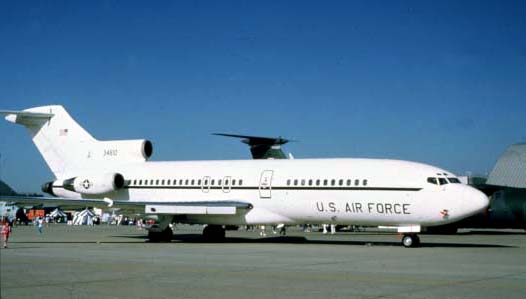C-22 B

Mission
The C-22B, a Boeing 727-100, is the primary medium-range aircraft used by the Air National Guard and National Guard Bureau to airlift personnel.
Features
The C-22B's unique arrangement of leading-edge devices and trailing-edge flaps permit lower approach speeds, thus allowing operation from runways never intended for a 600-mph (Mach 0.82) aircraft.
The aircraft has heated and pressurized baggage compartments - one on the right side forward and the second just aft of the wheel well. The two compartments provide 425 cubic feet (12.75 cubic meters) of cargo space. The fuselage also incorporates a forward entry door and hydraulically opened integral aft stairs in the tail cone.
The flight controls consist of a hydraulically powered dual-elevator control system with control tab to assist during manual operation. Hydraulically powered rudders use two main systems with a standby system for the lower rudder. The ailerons also are powered by dual-hydraulic systems. They have balance tabs on the outboard and control tabs on the inboard, which assures adequate maneuverability in the event of a total hydraulic failure. The flight spoiler systems assist ailerons and also function as speed brakes. The aircraft's tricycle landing gear consists of a dual-wheel nose gear, left and right dual-wheel main gear, and a retractable tail skid which prevents damaging the aircraft in case of overrotation. Nose wheel steering is hydraulically powered and controlled by a steering wheel to approximately 78 degrees in either direction. Fuel is contained in three main tanks inside the wing center section. Rapid pressure fueling and defueling is accomplished at the fueling station on the right wing. The total fuel capacity is approximately 50,000 pounds (22,500 kilograms) of JP-4. Fuel may be dumped down to 35,000 pounds (15,750 kilograms) from all tanks.
The C-22B requires four crew members and three or four in-flight passenger specialists for passenger service and safety. The avionics package includes one UHF and two VHF radio altimeters, variable instrument switching and two Collins FD-108 flight directors. A third vertical gyro and an additional VHF transceiver are available in case of failure of the primary systems.
Background
The C-22B was introduced by the airline industry in 1963. It proved to be a major innovative design with its three Pratt & Whitney JT8D turbofan engines, one on each side of the rear fuselage and the third in the tail cone. Currently, there are three C-22B's in use, all assigned to the 201st Airlift Squadron, District of Columbia Air National Guard.
General Characteristics
Primary Function: Passenger transportation
Builder: Boeing Co.
Power Plant: Three JT8D-7 turbofan engines
Thrust: 14,000
pounds each engine
Length: 133
feet, 2 inches (40.3 meters)
Height: 34
feet, (10.3 meters)
Wingspan: 108
feet (32.7 meters)
Maximum
Take-off Weight: 170,000 pounds (76,500 kilograms)
Maximum
Payload: 20,000 pounds (9,000 kilograms)
Maximum
Speed: 619 mph (Mach 0.82)
Range: 2,000
miles (1,739 nautical miles)
Endurance: 5.5
hours
Crew: Pilot,
co-pilot, flight engineer, flight mechanic, and three or four in-flight
passenger specialists
Unit
Cost: No longer available.
Date
Deployed: 1963.
Inventory: Active
force, 0; ANG, 3; Reserve, 0.
